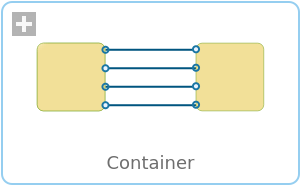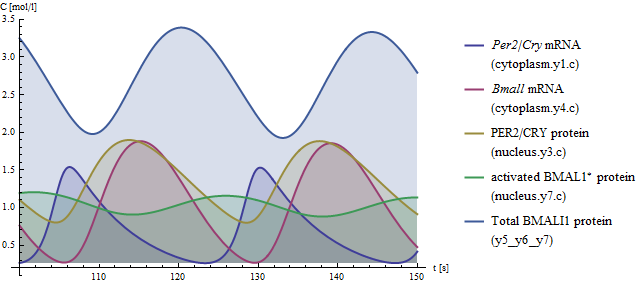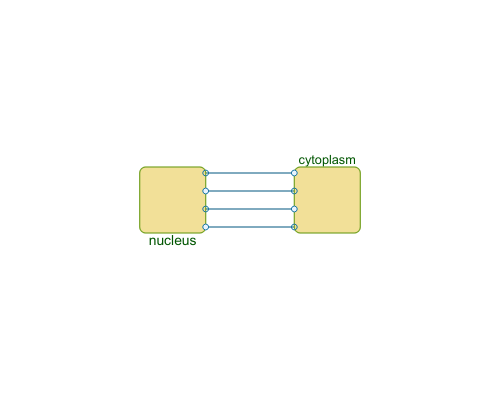WOLFRAM SYSTEM MODELER
ContainerMain model of the example |
|
Diagram
Wolfram Language
In[1]:=
SystemModel["BioChem.Examples.CircadianOscillator.Container"]
Out[1]:=

Information
This model descibres the circadian oscillator. Below follows an excerpt of the abstract from the paper describing the model by S. Becker-Weimann et al (2004).
"The suprachiasmatic nucleus governs daily variations of physiology and behavior in mammals. Within single neurons, interlocked transcriptional/translational feedback loops generate circadian rhythms on the molecular level. We present a mathematical model that reflects the essential features of the mammalian circadian oscillator to characterize the differential roles of negative and positive feedback loops. The oscillations that are obtained have a 24-hour period and are robust toward parameter variations even when the positive feedback is replaced by a constantly expressed activator. This demonstrates the crucial role of the negative feedback for rhythm generation. Moreover, it explains the rhythmic phenotype of Rev-erbalpha-/- mutant mice, where a positive feedback is missing. The interplay of negative and positive feedback reveals a complex dynamic. In particular, the model explains the unexpected rescue of circadian oscillations in Per2Brdm1/Cry2-/- double-mutant mice (Per2Brdm1 single-mutant mice are arrhythmic). Here, a decrease of positive feedback strength associated with mutating the Per2 gene is compensated by the Cry2-/- mutation that simultaneously decreases the negative feedback strength. Finally, this model leads us to a testable prediction of a molecular and behavioral phenotype: circadian oscillations should be rescued when arrhythmic Per2Brdm1 mutant mice are crossed with Rev-erbalpha -/- mutant mice."
Fig. 1 show the simulation results and corresponds to Fig. 3(a) in the paper (S. Becker-Weimann et al 2004).

Fig. 1 the model predictions for the oscillations of clock gene mRNAs an proteins.
"The suprachiasmatic nucleus governs daily variations of physiology and behavior in mammals. Within single neurons, interlocked transcriptional/translational feedback loops generate circadian rhythms on the molecular level. We present a mathematical model that reflects the essential features of the mammalian circadian oscillator to characterize the differential roles of negative and positive feedback loops. The oscillations that are obtained have a 24-hour period and are robust toward parameter variations even when the positive feedback is replaced by a constantly expressed activator. This demonstrates the crucial role of the negative feedback for rhythm generation. Moreover, it explains the rhythmic phenotype of Rev-erbalpha-/- mutant mice, where a positive feedback is missing. The interplay of negative and positive feedback reveals a complex dynamic. In particular, the model explains the unexpected rescue of circadian oscillations in Per2Brdm1/Cry2-/- double-mutant mice (Per2Brdm1 single-mutant mice are arrhythmic). Here, a decrease of positive feedback strength associated with mutating the Per2 gene is compensated by the Cry2-/- mutation that simultaneously decreases the negative feedback strength. Finally, this model leads us to a testable prediction of a molecular and behavioral phenotype: circadian oscillations should be rescued when arrhythmic Per2Brdm1 mutant mice are crossed with Rev-erbalpha -/- mutant mice."
Fig. 1 show the simulation results and corresponds to Fig. 3(a) in the paper (S. Becker-Weimann et al 2004).

Fig. 1 the model predictions for the oscillations of clock gene mRNAs an proteins.
References
S. Becker-Weimann, J. Wolf, H. Herzel, A. Kramer, "Modeling Feedback Loops of the Mammalian Circadian Oscillator," Biophysical Journal, 87(5), 2004, pp. 3023-3034 doi:10.1529/biophysj.104.040824Parameters (25)
| mainCompartment |
Value: true Type: Boolean Description: Specifies whether the compartment is a main (top-level) compartment. Used in SBML import/export. |
|---|---|
| v1b |
Value: 9 Type: Real |
| c_sbml |
Value: 0.01 Type: Real |
| k1b |
Value: 1 Type: Real |
| k1i |
Value: 0.5600000000000001 Type: Real |
| hill_coeff |
Value: 8 Type: Real |
| v4b |
Value: 3.6 Type: Real |
| r_sbml |
Value: 3 Type: Real |
| k4b |
Value: 2.16 Type: Real |
| k1d |
Value: 0.12 Type: Real |
| k2b |
Value: 0.3 Type: Real |
| q |
Value: 2 Type: Real |
| k2d |
Value: 0.05 Type: Real |
| k2t |
Value: 0.24 Type: Real |
| k3t |
Value: 0.02 Type: Real |
| k3d |
Value: 0.12 Type: Real |
| k4d |
Value: 0.75 Type: Real |
| k5b |
Value: 0.24 Type: Real |
| k5d |
Value: 0.06 Type: Real |
| k5t |
Value: 0.45 Type: Real |
| k6t |
Value: 0.06 Type: Real |
| k6d |
Value: 0.12 Type: Real |
| k6a |
Value: 0.09 Type: Real |
| k7a |
Value: 0.003 Type: Real |
| k7d |
Value: 0.09 Type: Real |

